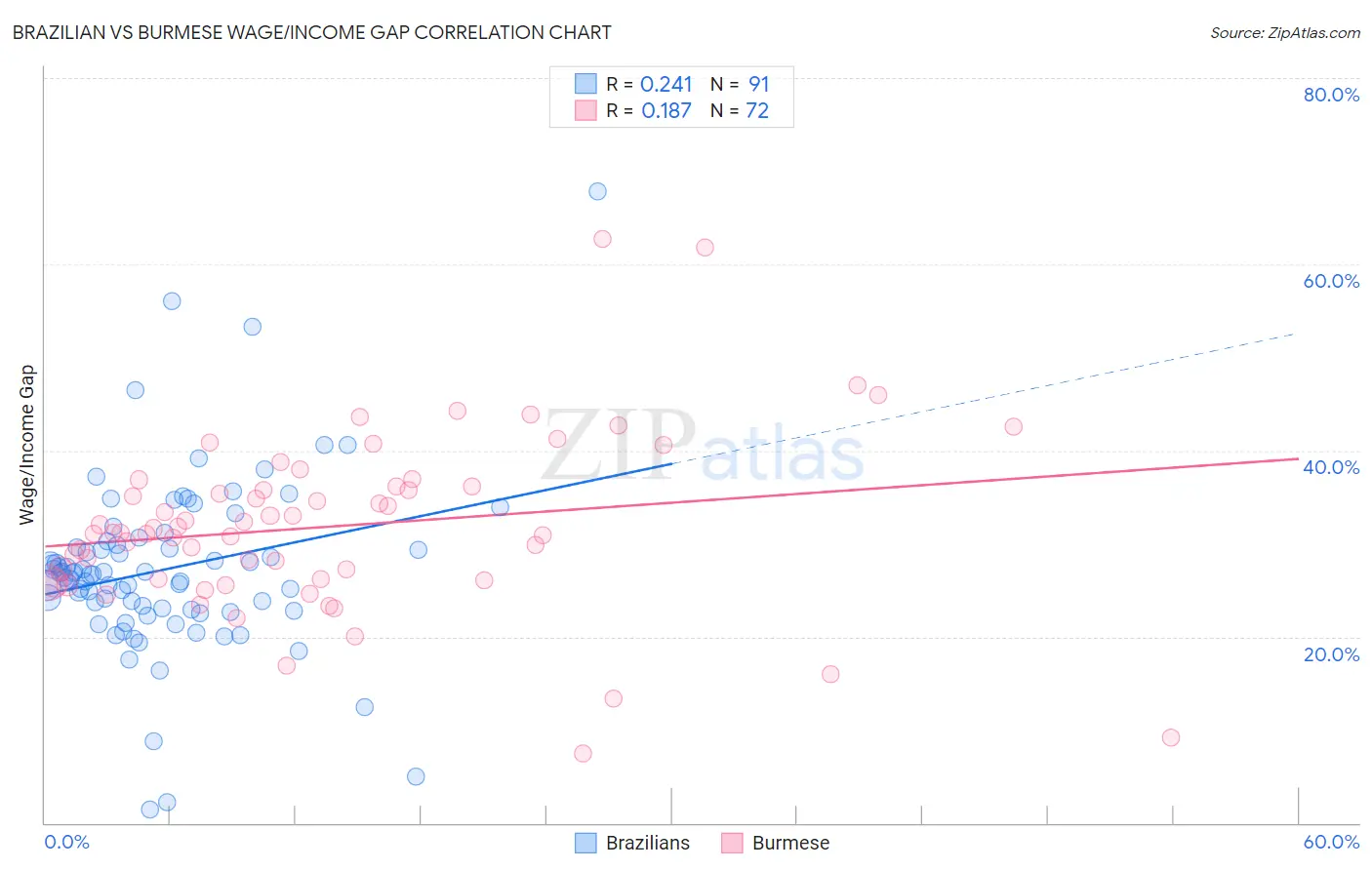Brazilian vs Burmese Wage/Income Gap
COMPARE
Brazilian
Burmese
Wage/Income Gap
Wage/Income Gap Comparison
Brazilians
Burmese
26.7%
WAGE/INCOME GAP
9.2/ 100
METRIC RATING
217th/ 347
METRIC RANK
28.0%
WAGE/INCOME GAP
0.5/ 100
METRIC RATING
281st/ 347
METRIC RANK
Brazilian vs Burmese Wage/Income Gap Correlation Chart
The statistical analysis conducted on geographies consisting of 323,810,201 people shows a weak positive correlation between the proportion of Brazilians and wage/income gap percentage in the United States with a correlation coefficient (R) of 0.241 and weighted average of 26.7%. Similarly, the statistical analysis conducted on geographies consisting of 464,918,136 people shows a poor positive correlation between the proportion of Burmese and wage/income gap percentage in the United States with a correlation coefficient (R) of 0.187 and weighted average of 28.0%, a difference of 4.8%.

Wage/Income Gap Correlation Summary
| Measurement | Brazilian | Burmese |
| Minimum | 1.4% | 7.4% |
| Maximum | 67.8% | 62.7% |
| Range | 66.4% | 55.3% |
| Mean | 27.2% | 31.9% |
| Median | 26.7% | 31.2% |
| Interquartile 25% (IQ1) | 22.9% | 26.1% |
| Interquartile 75% (IQ3) | 29.9% | 36.1% |
| Interquartile Range (IQR) | 7.0% | 10.0% |
| Standard Deviation (Sample) | 9.5% | 9.5% |
| Standard Deviation (Population) | 9.5% | 9.5% |
Similar Demographics by Wage/Income Gap
Demographics Similar to Brazilians by Wage/Income Gap
In terms of wage/income gap, the demographic groups most similar to Brazilians are Immigrants from Saudi Arabia (26.7%, a difference of 0.030%), Immigrants from Portugal (26.7%, a difference of 0.050%), Immigrants from Poland (26.7%, a difference of 0.050%), Immigrants from Latvia (26.7%, a difference of 0.070%), and Yugoslavian (26.7%, a difference of 0.10%).
| Demographics | Rating | Rank | Wage/Income Gap |
| Arabs | 12.3 /100 | #210 | Poor 26.6% |
| Mongolians | 11.4 /100 | #211 | Poor 26.6% |
| Iraqis | 11.2 /100 | #212 | Poor 26.6% |
| Immigrants | Iraq | 10.3 /100 | #213 | Poor 26.7% |
| Immigrants | China | 10.3 /100 | #214 | Poor 26.7% |
| Yugoslavians | 9.7 /100 | #215 | Tragic 26.7% |
| Immigrants | Portugal | 9.5 /100 | #216 | Tragic 26.7% |
| Brazilians | 9.2 /100 | #217 | Tragic 26.7% |
| Immigrants | Saudi Arabia | 9.1 /100 | #218 | Tragic 26.7% |
| Immigrants | Poland | 8.9 /100 | #219 | Tragic 26.7% |
| Immigrants | Latvia | 8.9 /100 | #220 | Tragic 26.7% |
| Immigrants | Spain | 8.5 /100 | #221 | Tragic 26.8% |
| Bolivians | 8.3 /100 | #222 | Tragic 26.8% |
| Jordanians | 8.0 /100 | #223 | Tragic 26.8% |
| Immigrants | Argentina | 7.2 /100 | #224 | Tragic 26.8% |
Demographics Similar to Burmese by Wage/Income Gap
In terms of wage/income gap, the demographic groups most similar to Burmese are South African (28.0%, a difference of 0.030%), Russian (28.0%, a difference of 0.050%), Romanian (28.0%, a difference of 0.20%), French Canadian (28.1%, a difference of 0.21%), and Immigrants from Sweden (28.1%, a difference of 0.22%).
| Demographics | Rating | Rank | Wage/Income Gap |
| Americans | 0.7 /100 | #274 | Tragic 27.8% |
| Immigrants | Japan | 0.7 /100 | #275 | Tragic 27.9% |
| Lebanese | 0.7 /100 | #276 | Tragic 27.9% |
| Latvians | 0.7 /100 | #277 | Tragic 27.9% |
| Immigrants | England | 0.6 /100 | #278 | Tragic 27.9% |
| Romanians | 0.5 /100 | #279 | Tragic 28.0% |
| Russians | 0.5 /100 | #280 | Tragic 28.0% |
| Burmese | 0.5 /100 | #281 | Tragic 28.0% |
| South Africans | 0.5 /100 | #282 | Tragic 28.0% |
| French Canadians | 0.4 /100 | #283 | Tragic 28.1% |
| Immigrants | Sweden | 0.4 /100 | #284 | Tragic 28.1% |
| Italians | 0.4 /100 | #285 | Tragic 28.1% |
| Immigrants | Austria | 0.4 /100 | #286 | Tragic 28.1% |
| Okinawans | 0.4 /100 | #287 | Tragic 28.1% |
| Choctaw | 0.4 /100 | #288 | Tragic 28.1% |